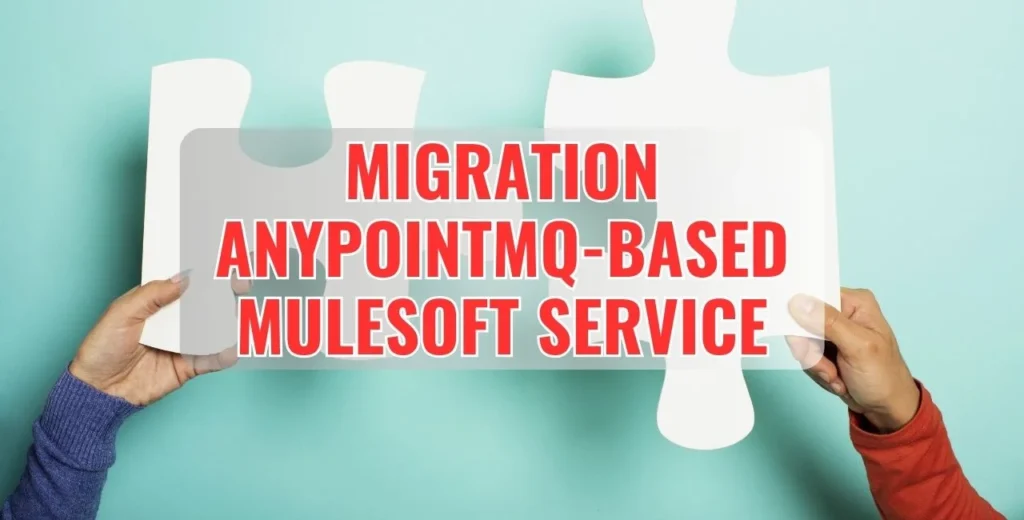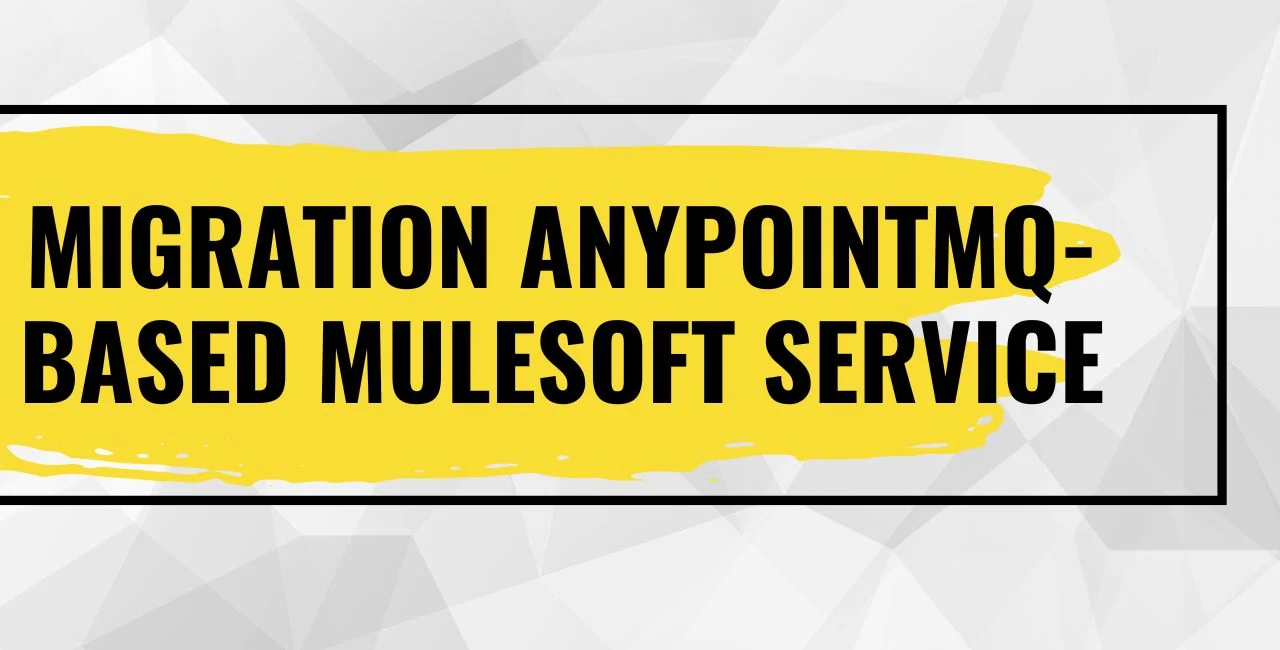In this article, we are going to show how we transmigrate Migration AnypointMQ-Based Mulesoft Service linked to AnypointMQ-based messaging platform systems into proper serverless tectonics. So, let’s begin with the present unification architecture on the Mulesoft platform.
Current architecture
We actually have two Mulesoft services involved in our platform, so let’s begin with the first service, which acts as a producer; in other words, we can say that a manufacturer of any goods, and the second one is the consumer, who buys the products. The producer’s work is to receive messages from the web, mobile phones, and different internal enterprise services with a REST at the endpoint. And it also puts the consignment into the AnyPointMQ category. This information is delivered in the form of a message to the series after being changed into a standard way (canonical) for utilization by all users in the corresponding enterprises. In addition, important messages visit several standard authentication sites before they are changed.
The second service is derived as a user service that rescues the message from the AnyPointMQ category. The message is then sent in the colonial format to CSV or space-separated cost and navigated to the relevant FTP folder.
Also Read:- Turbocharging Development | Demystifying Clouds Trend
Serverless Architecture
When moving on to the serverless architecture, it is important to carefully select the authentic methods and components to remove the present ones. In this situation, we are deputizing MuleSoft with AWS lambda, Amazon SQS, AnypointMQ, and, lastly, Anypoint designer with Kumologica.
So you must remember that in this architecture, AWS Lambda will be provided as the platform for hosting purposes, providing an excellent serverless total unit for our services. On the other hand, Amazon SQS will take the place without putting any effort into AnyPointMQ and ensure there is no effect on the delivered messages mechanism while using the advantages of a serverless messaging organization. Denude APIs from outside the globe will be accessed through the AWS API doorway.
For growth and development requirements, the Kumologica designer has a codeless growth implementation that is the same as the MuleSoft that will be hired. The main purpose of this tool is to migrate Mule flows to Kumologica flows and ensure a smooth epidemic and convenience for the growth of our services.
Building the Service
We will construct the services with the help of the Kumologica designer. Kumologica flows are mainly dependent on NodeJS, so we need to install it on our devices. The primary thing we are going to do is construct the generator service, which puts the message into the category.
Producer service
The producer service in Mulesoft is revealed by utilizing APIK it navigator and is an HTTP related endpoint that admits the request consignment in JSON pattern. The admitted JSON pattern is changed to CSV pattern or tab-separated pattern by the help of dataweave. It is related with one of the properties in the consignment, the selected navigator in the flow will choose between which FTP connector is required to deliver the final file.
Note: Dataweave processor in Mulesoft mainly uses dataweave actions, therefore if we move to datamapper it mainly uses JSONata actions, JSONata actions are same as the dataweave with several dissimilarities in syntax and its performances. The two of them follow a performance connection.
Consumer service
In terms of consumer service, AnyPoint listeners select the message from AnyPoint MQ. So, we found the target area quality in the message by utilizing the selected navigator, and the motion will choose whether it will change to a CSV category or a tab-separated payload. This kind of information is sent using dataweave. The changed message is then sent to the FTP joiner.
A journey from MuleSoft to Serverless integration
Is MuleSoft becoming a legacy platform?
So, as we know in the present, the highly unexpected changes in the market trends like the price command interpreter, unending portability, and dexterous growing implements are very important for any vocation digitized roadmap. The fastest developing trends of Google Cloud function, AWS Lambda, and Azure FN have recently gained the identity of small, medium, and huge enterprises, and this shows that the motion from the iPaaS to FaaS is unavoidable and natural. This step unwinds a modern society of serverless integration.
Key Features of Serverless Integration

Some of the key features of serverless integration are listed below:
- Infrastructure Ready: in this part, you are not required to manage servers or rules.
- Scalability: The service will immediately show up to assist the price of the inward requests, which consists of the capacity to scale to zero.
- Quick turn Around: All the enterprises can now focus on 100% of performance and can create sudden transformation based on the consumer feedback.
- Cost-Efficiency: By lifting the time interval surveying of your cloud generator to minimize prices. You only need to pay for integral services only if they run properly.
Also Read:- The Power of @ngrx/signalstore | Revolutionizing Network Operations With Automated Solutions
Kumologica
This is known as one of the primary players in this area who gives the advantages of the codeless unification ability of cultural integral such as; MuleSoft to the unwind society of serverless. It gives you permission to pull down an imaginary designer and codeless outlook to make sure about the highest accuracy of speed and suppleness to assist a huge range of unification coherent with most of the cloud generators and platforms.
Note: Dataweave is a possessive high technology launched from MuleSoft for actions related details, navigating whereas kumologica datamapper will be using JSONata technology for making the change in details.
Use case: In terms of the use case, we will be constructing a basic product availability API flow, which will call an outer layered system (warehouse unit) with HTTP resting final stage. Based on the product category area in the request, the instance will be navigated to the authentic warehouse unit. Warehouse unit A gives answers in XML outlay, whereas warehouse unit B answers in JSON outlay. The answers that you get from the warehouse units will be changed to an ordained detail format in JSON structure.
Implementation:The implementation captures a motion that has a tiny set of strings or processors in Kumologica and MuleSoft. To get a detailed description, you can visit us, and we will give you intensive plunge examples and demos.
Deployment: MuleSoft moves are open on cloudhub which is a cloud related area for performing mule applications. Kumologica applications can be open on any of the cloud generator of user choices that ignores the cloud generator locking system.
Kumologica moves are open either as an AWS in lambda or as a performance in Azure or Google based on the Komologica functioning time period of user choices.
Conclusion: Migration AnypointMQ-Based Mulesoft Service
This essay mainly shows the easy development of an integration motion or an API motion in Kumologica Designer, the same as MuleSoft, and receiving all the advantages of a serverless community.
To test about the shown product availability kumologica moves you to import and download from the kumologica designer. And at last always keep in mind that kumologica is very helpful and it’s free of cost for downloading and using it. You should move ahead and give this awesome application, if you like it then please share feedback regarding kumologica, we are waiting for your feedback and we will love to look at your feedback.
